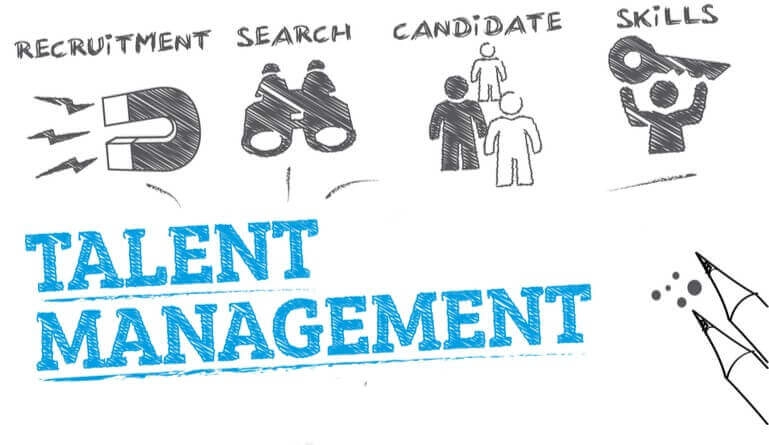When a business conducts the process of scouting, obtaining, training, appointing, and molding employees, it is called talent management. The end goal of performing these steps is to ensure that a business brings on the best and the brightest people to create a highly talented workforce. The human resources (HR) sector of a business usually manages this process.
Why is Talent Management Important?
- It raises the standards and efforts of production outcomes
- Keeps business operations assertive and on the cutting edge
- Encourages originality and change
- Improves collaboration amongst employees
- It lessens the staff leave rate
- Strengthens the brand of the company
- Leads to growth in both employer and the employees
What is Talent Management Process?
To begin the process, a business must know that they are in a need of new talent. This might sound obvious, but if an organization does not know what sectors and departments are in need of improvement then the opportunity for growth could be squandered through disorganization. That is why it is imperative for a business to have a strategy in order to increase effort and results.
-
Planning
This first step in the talent management process requires an organization to investigate and find out what is lacking inside business operations. This helps to shape possible solutions that will be initiated in helping to find the best people for the job.
-
Attracting
Once a business finds out what is needed for improvement, the recruitment process begins. No matter if an organization is seeking talent from within the company or from the outside through job application platforms, the goal is to state the requirements of the role and have incentives to ensure that only high-quality candidates apply for the position.
-
Selecting
Before selecting a candidate, a company must have a series of assessments and trials to check if the person that they are about to choose for the job has actual experience and knowledge of the role that they applied for. This includes interviews, tests, and using an applicant tracking system (ATS) to look for keywords in resumes and CVs.
-
Developing
Once hired, a new employee has to be formally introduced into what their role at the company entails and the expectations that they are expected to follow. Training needs to function as a way to help newly hired employees mature in their role to establish loyalty and focus with the company.
-
Retaining
For a team of employees to be cohesive, have effective collaboration, and have a diverse set of skills, there must be an incentive to stay with the company. Raises in salary and promotions are good reasons to stay with a company. Every time an employee leaves, what they brought to the table in terms of talent is not easily replaced.
-
Transitioning
Not only is the goal of the talent management process to facilitate an environment in which a company can grow. The growth of employees on an individual level is a top priority as well. This means that a business must make sure that each employee is an important contributor to the success of the organization. It also includes offering career transitioning benefits like retirement packages, role elevation planning after promotion, etc.
Talent Management Model
-
Obtain
Staff branding, enlisting, training
-
Evaluate
Talent data, elevation planning, tests
-
Create
Staff organization, workplace environment, participation, and retainment strategies
-
Utilize
Objective alignment, occupational organization, training and growth, and production operations
Talent Management Initiatives
- Acknowledgment
- Compensation and benefits
- Giving chances
- Position arrangement
- Onboarding and growth
- Task rotation
- Succession arrangement
- Adaptability
- Overseeing relationships
- Ambition
( Also Read: Best Talent Management Software in 2020 )
Key Components of Talent Management?
- Attaining talent and enlisting
- Staff development
- Company goals and beliefs
- Oversight of employee output
- Arranging the succession of roles
Benefits of Talent Management for the Organization
- Achieving goals
- Keeping the best and brightest employees within the company
- Creates a strong work environment for workers
- Having an upper hand over the competition
- Establishing a good reputation for the company
- Making better choices
- Maximizing and enhancing work output
Benefits of Talent Management for Employees
- Gain job fulfillment
- Employee enthusiasm
- Increases workforce skills and abilities
- Welcoming work environment
- Ensures long-term work relationships with the company and other employees
- Increases confidence
- High-level add-ons to the work experience
Metrics to be Considered in Measuring Talent Management?
- Retainment rate.
- Employee commitment.
- Inside vs. outside employment (to manage and monitor advising and on-boarding).
- Opinions on hiring procedures from potential employees.
- The amount of time that it takes to hire employees.
- Applicant rates.
- Gainful hires.
Current Trends in Talent Management
-
Competing for talent
The main goal of talent management is discovering and keeping talent within an organization. But the hunt for talent can be steep due to the globalization of the modern market. This means that companies are competing with other companies for skilled workers not just within their respective industries, but with organizations from around the world.
-
Digital platforms and Talent Management
Human resource departments in businesses across various industries have been utilizing digital platforms to assist in the talent management process. Digital portals also store employee information and have become commonplace in order to oversee the distribution of benefits, career oversight, and improving business and employee relations all in one place.
-
Inside promotion
When businesses fill job roles from within the company, it fosters the retainment of the skills and talent of employees already in the system. Plus, it also creates an environment for employees to grow into even bigger roles within the company down the line.
-
Global demographic changes
Across the world, various countries have either experience the growth of extremely young populations or increasingly elderly populations. For the former, are expecting to experience a boom in new and up-and-coming members of the workforce, which means more talent. For the latter, the older the population becomes the more that it is likely to be a talent shortage in the near future.
-
Reliance on Talent Management by HR
Thanks to talent management, HR has the ability to not only analyze employee numbers, but they can also focus on employee skills and growth within a company. This leads to more comprehensive strategies to ensure that talent is retained within the company and that those skills are properly utilized across all departments and sectors.
-
The rise in company perception
When a business treats its employees right, the way that the organization as a brand is perceived by its’ workers increases. This leads to attracting more talent because when a business is known for being employee-friendly, more people will want to be a part of that organization.
Difference Between Talent Management and Talent Acquisition
As discussed earlier in this piece, talent management is about to retain and nurturing employee talent within the company to ensure its success within the industry. With talent acquisition, the focus is mainly on the actual recruitment and employment of qualified candidates.
To remember the differences between these two terms, just remember that the word implies management is long-term oversight of a process while acquire is the actual act of attaining or gaining something.
Final Thoughts
When a business is in search of candidates to fill their job positions, it is not as simple as looking for people with the most experienced in the industry or choosing the one that has the personality that is the best “fit” within the company culture.
Although these factors are considered in the process, the main goal is to investigate a candidates’ skill set and what knowledge can bring to help grow the company.
The process of talent management ensures that the company can raise, grow, and utilize its talent force from scratch to create an environment of long-term work relationships between the employer and employees.
Talent retainment is essential in these modern times because it is no longer the norm for an employee to stay with a company for 30 years and then retire into the sunset. Companies have to create strategies that use incentives to encourage employees to stay longer than 2-3 years.
This ensures that employees are never taken for granted for their hard work and contributions to making a company a success. This means that not only do employees grow in their skillset, but companies also grow in how they treat their employees.
When businesses create healthy workplace environments for their employees, then those employees become more productive. The more work output is produced by employees, then the more successful a company becomes due to quality products and services. It is a cycle where fulfilled employees create better businesses.
***
Kierra Benson is an alumnus of the University of North Texas at Dallas with a Bachelor’s degree in Communication and Technology. She previously completed an internship at a local newspaper and worked as a content creator for a small online business. Her goal is to work in the media industry in writing/editing and advertising. She has always been fascinated by how messages are marketed in the media to influence the masses and sell products. Connect with her on LinkedIn.








